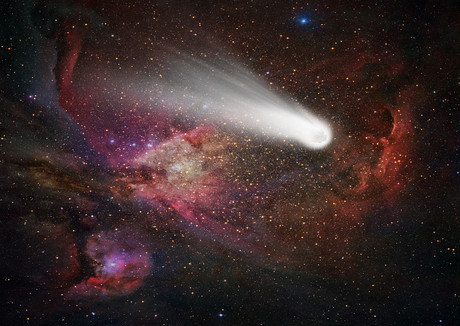Data rates double for NASA communications network

The NASA communications network that serves a variety of spacecraft, including the International Space Station, will have its data rate doubled.
The Space Network (SN) is composed of a constellation of tracking and data relay satellites (TDRS) and their associated ground stations.
Currently, the SN provides connectivity to and from the station at 300 megabits per second (Mbps), twice the rate of a typical high-speed internet connection in American homes. The increased data rate will support new, more sophisticated instruments that require a greater data flow.
"Fundamentally, this upgrade of both the onboard and ground data communications systems enables an increase in the scientific output from the space station," said Mark Severance, network director of human spaceflight at NASA's Goddard Space Flight Center in Greenbelt, Maryland.
"Increasing the data downlink rates from the station will allow the manifestation of new experiments and technology demonstrations that have higher data-rate requirements than could previously be accommodated."
Data transmitted by the station includes time-sensitive, mission-critical data such as information about the crew's health, the status of the station's systems, results from onboard science experiments, as well as social media posts and interviews. Flight controllers at NASA's Johnson Space Center in Houston receive the station's tracking and command data primarily from the SN.
Increasing the data rate will begin at the Space Network's remote ground terminal in Guam. The SN team installed a 300 Mbps data downlink capability at the facility to increase data-flow capability to and from the station to the current standard. They will install upgraded hardware at the White Sands, New Mexico and Guam ground terminals to enable the space station to double its data return.
In addition to the space station, the SN makes connections, recorded as ‘events’, with more than 40 other NASA missions, including the Hubble Space Telescope. In total, the Space Network handles more than 900,000 minutes of data a month with over 13,000 communication events. This equates to an average of 28 terabytes of information every day.
The SN will add another TDRS spacecraft to its fleet in 2017. TDRS-M is scheduled to launch from Cape Canaveral, Florida, aboard a United Launch Alliance Atlas-V launch vehicle in late summer. Upon completion of on-orbit testing (about six months), TDRS-M will be renamed. Built by Boeing, TDRS-M will greatly increase network capacity and flexibility.
At the same time, the Space Network Ground Segment Sustainment project is working to bring the Space Network's ground terminals into the 21st century. The team has been working to implement a new architecture that allows the network to accommodate new users and capabilities. An added bonus includes reducing the effort required to operate and maintain the system, a potential savings in operation costs.
Customised rugged tech shaping the next era of defence comms
Rugged computing platforms are becoming central to how armed forces protect communication...
A guide to aquatic survival this summer
While most Australians are planning aquatic adventures this summer, less than a third are...
Maher Terminals enhancing operations with private wireless
Maher Terminals chose the Nokia Edge platform because it needed a secure, reliable,...



